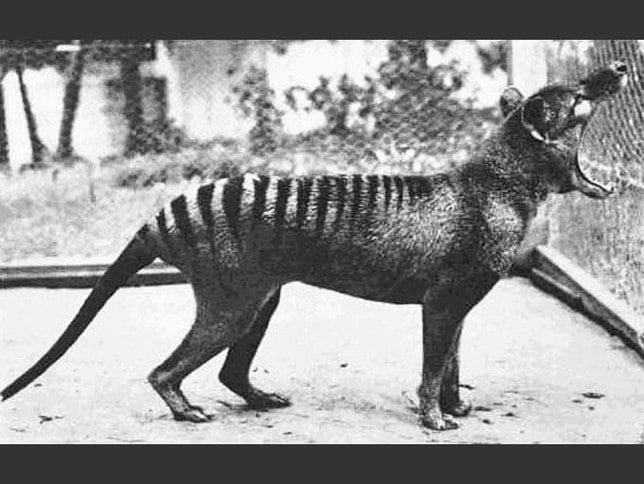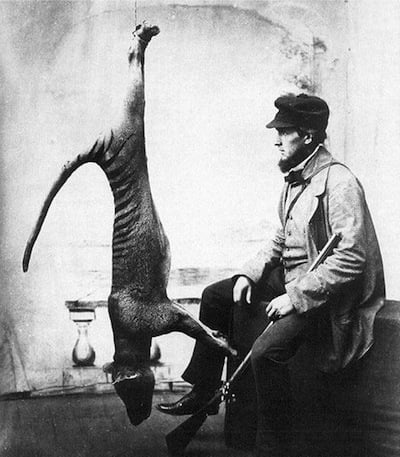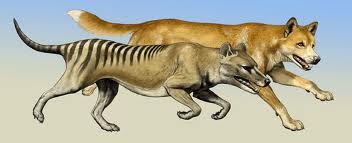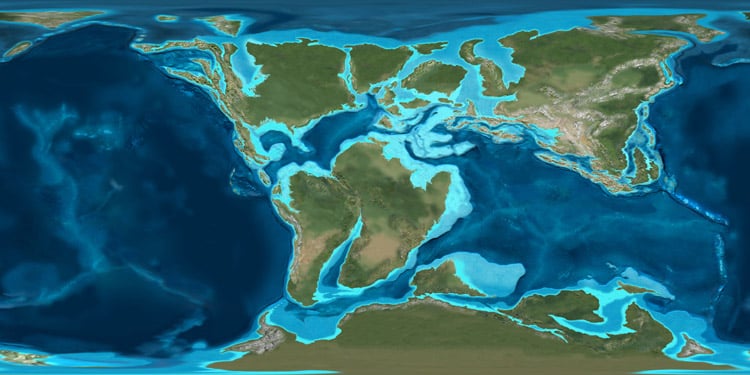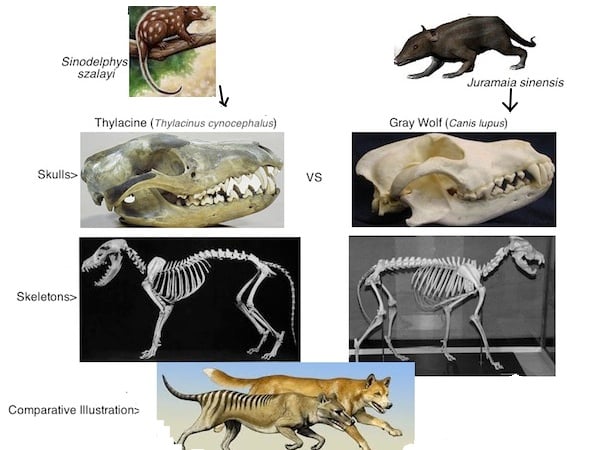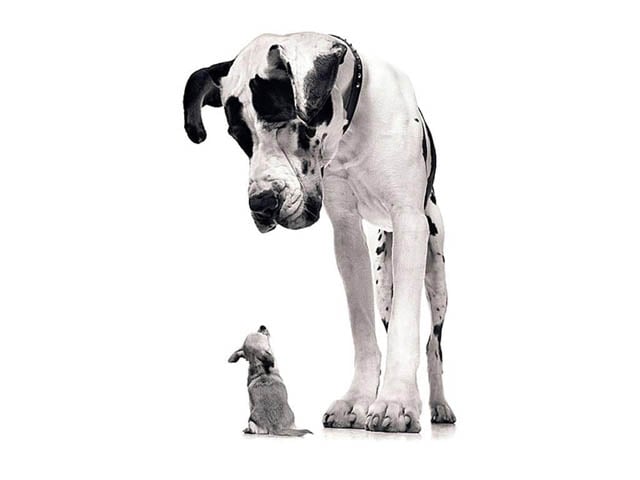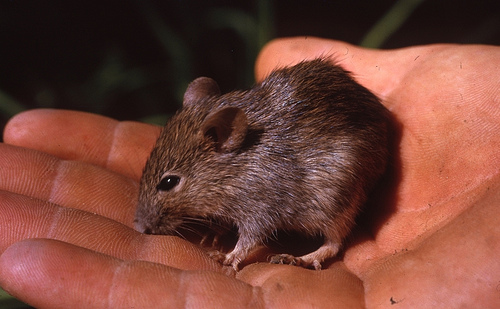The Fall of the Thylacine:
The Thylacine (Thylacinus cynocephalus) was the largest known carnivorous marsupial of modern times. Tragically, in the mid 20th century these magnificent creatures joined the 99.9% of all living organisms to have existed and subsequently gone extinct. Their last ecological refuge was on the island nation of Tasmania; with fossil evidence suggesting these predators had gone extinct on the mainland of Australia by approximately 2 thousand years ago. The arrival of Europeans on the island nation of Tasmania was reported to have occurred in the mid 17th century and would prove devastating to many native plants and animals.
At the time of their arrival, the Europeans had an impoverished understanding of the fragility of island ecosystems and did not pay much attention to the impact their accidental introduction of non-native flora and fauna would have on the island. Of all the non-native species introduced by the Europeans, the feral dogs played a larger role in the demise of the ‘marsupial wolf’ than any other nonhuman animal. The thylacine would now have to compete for some of its prey items with the non-native, feral dogs introduced by the Europeans. Farmers became infamous for their reckless slaughter of thylacines out of a misallocated blame for predation of their livestock . Although it is possible that thylacines were responsible for some of the predation of the European immigrants livestock; it seems the primary killer of the farmers livestock wasn’t the thylacine at all, rather the feral dogs they themselves introduced.
Originally believed to have preyed on relatively large animals (kangaroos, wombats, etc.), recent anatomical studies at the University of New South Wales suggests the jaws of these predators were far too feeble to handle prey items of that size. Instead, the thylacine was probably a much more specialized hunter of smaller animals (possums, potoroos, wallabies, birds, etc.) than was traditionally believed. However, in the 19th and early 20th century the Tasmanian Government and various independent land companies placed bounties on these marsupial predators; quickly leading them to extinction. After only 3 years in captivity, the last wild-caught, captive member of the species died in 1936 at the Hobart Zoo in Tasmania.
Anatomical / Biological Comparison Between Thylacines and (Gray) Wolves:
Sexual Dimorphism: Males larger in both Wolves and Thylacines.
Adult Weight: Wolves – Males up to 100 lbs. Thylacines- Males up to 70 lbs.
Dental Formula: Wolves – Upper 3:1:4:2, Lower 3:1:4:3. Thylacines – Upper 4:1:3:4, Lower 3:1:3:4
Body Length: Wolves – Males up to 63 inches long. Thylacines – Males up to 51 inches long.
Tail Length: Wolves – 11-20 inches long. Thylacines – 20-26 inches long.
Height at Shoulder: Wolves – 32-34 inches. Thylacines – 20-25 inches.
Primary Sense(s) Used in Hunting: Wolves – Scent. Thylacines – Sight, Sound.
Life Expectancy in Wild: Wolves – 10-18 years. Thylacines – 5-7 years.
Behavioral Comparison Between Thylacines and (Gray) Wolves:
Hunt During: Wolves – Crepuscular, usually hunting at dusk or dawn. Thylacines – Usually, nights.
Hunting Strategy: Both wolves and thylacines show evidence for hunting in packs, though the methods used in social hunting are notably different.
Social Structure: Wolves – Highly territorial and hierarchal packs of 5-11 animals (usually a mated pair and their offspring) with an average core territory of approximately 15-20 square miles. Thylacines – Less territorial, groups of animals much too large to be a single family were often reported. The typical core territory of thylacine groups was approximately 15-20 square miles.
Breeding: Wolves – Breed from Jan-April, the higher the elevation the later the breeding occurs. Thylacines – believed to have bred year round.
Gestation Period: Wolves – 62-75 days. Thylacines – Unknown, but because marsupials give birth to relatively undeveloped young, their average gestation period is approximately 14 days.
Number of Offspring: Wolves – usually 5-6 pups. Thylacines – usually 2-4 joeys.
Time Spent with Mother: Wolves – Begin hunting with pack at 6-8 months, and offspring may live in natal pack for whole life. Thylacines: In mothers pouch until up to 3 months, close to half the adult size. How long offspring would stay in natal groups is unknown.
Early Mammalian Evolution:
The origin of the class Mammalia takes us back over 200 million years to when the first mammalian species would diverge from the synapsids, often referred to as the ‘mammal-like reptiles’. These basal mammals would come to include such species as Hadrocodium, whose squamosal and dentary features were distinguishable from the reptilian synapsids from whom hadrocodium was descended. However, despite the early appearance of mammals, these warm blooded mutants would be forced to live in the shadows of their reptilian cousins for over 100 million years. Early mammals were often very small, likely spending much of their time burrowing and searching for insects while avoiding becoming a meal themselves.
It was not until after the extinction of the dinosaurs during the K-T extinction event, some 65.5 million years ago, that mammals were able to rise to the dominate position they now occupy in many environments. However, difficult to grasp though it may be, by the time the dinosaurs had gone extinct, all three extant subclasses of class Mammalia had already diverged and begun to develop unique characteristics. These subclasses include the Eutherians (placental mammals), Metatherians (marsupial mammals) and the Prototherians (monotremes or ‘egg-laying mammals’). The fossil record shows that the earliest of these mammal subclasses to be distinguishable was the eutherians. Most scientific data suggests that the egg laying mammals diverged from the placental mammals prior to the divergence of placental and marsupial mammals, which is estimated to have occurred approximately 125 million years ago.
Evolutionary Relationship Between Thylacines and Canids:
The outward, physical similarities thylacines bear to modern canids (wolves, foxes, coyotes, dogs, etc.) earned them the misleading name ‘the marsupial wolf’. This name is misleading because not only was the thylacine not a wolf, these carnivorous marsupials were not in the canid family at all. Like us, wolves are eutherian mammals; meaning they are mammals which provide nutrients to their unborn young via a placenta and give birth to relatively developed young. The offspring of placental mammals are often highly reliant on their mothers for varying intervals of time, however they are able to live supervised outside of the mothers body. Thylacines and all other marsupials belong to the mammalian infraclass Metatheria; generally characterized by mothers giving birth to relatively undeveloped young which are unfit for life outside their mothers body, and thus spend varying intervals of time inside the mothers abdominal pouch before emerging to live exclusively outside.
Within the marsupials there are some odd exceptions to the pouch trend. Some opossum species lack abdominal pouches, but are more closely related to metatherians than eutherians and thus are placed in the marsupial subgroup. Some of such opossum species have ‘skin flaps’ over their mammae (nipples), homologous to the mammae containing pouches of their marsupial predecessors. Thylacines did have the abdominal pouches characteristic of most marsupials, and are only very distantly related to wolves as a matter of fact. To really begin to grasp just how long ago the evolutionary lineage leading to wolves diverged from the lineage leading to thylacines, we must venture to the lower Cretaceous period, some 125 million years before the present.
Pictured above is an approximation of the earth’s geography during the lower Cretaceous period. Marsupial fossils are primarily distinguished from eutherian mammal fossils by their dentition; with early metatherians generally having 4 pairs of molar teeth while eutherians never have more than 3. The fossil record reveals that the lineage which led to eutherian mammals appeared about 160 million years ago, some 35 million years before the first evidence for marsupial mammals.
Currently, the oldest verified eutherian mammal fossil is that of Juramaia sinensis, a tiny mammal with dentition and forepaws more characteristic of eutherian mammals than of the metatherians. During the lower Cretaceous, about 125 million years ago, the first known metatherian called Sinodelphys szalayi lived in the region that would become northeastern China. Sinodelphys was a mouse sized, marsupial predator whose anatomy suggests they spent their lives scampering through ground flora in pursuit of insects.
The fossil record reveals that by 110 million years ago, marsupials had migrated west to what is now Utah in the United States of America. Marsupials were able to quite successfully adapt and spread across the planet’s terrestrial environments; some capable of bridging gaps between landmasses using series of volcanic islands. The southern supercontinent known as Gondwana was comprised of what is now Australia and Antarctica, and was connected to what is now South America via a chain of volcanic islands. Many species of animal were able to spread from their land of origin to various other regions using similar volcanic ‘land bridges’. Geological evidence reveals that South America remained connected to Australia via a series of land masses until approximately 35 million years ago.
Over millions of years of ecological specialization forming as a result of natural selective pressures, many new species of marsupials had successfully expanded their distribution from northeastern China across the world. However, in many of their habitats, marsupials were competing for resources with the equally adaptable and diverse eutherian mammals of their time, as well as the reptiles and birds which occupied the same habitat. Using Antarctica as a bridge, fossil evidence suggests that primitive marsupials had reached the area of the world now known as Australia by approximately 50 million years ago, during a period of geological history known as the Eocene. Though the marsupial diversity and nearly all its populations in other parts of the world were eventually destined for a steep decline, Australia would become a sort of experimental breeding ground for a different type of mammal than those found in other parts of the world; the marsupials.
Convergent Evolution and Analogous Physical Traits:
By this point, I imagine some of you are wondering ‘How on earth can the two extravagantly different animals pictured above be so closely related as to have shared a common ancestor at least 10,000 years ago, if not even more recently; and yet the much more wolf-like (at least when judging strictly by their appearance) thylacine is some 125 MILLION years removed from wolves?’
Here is how – Convergent Evolution.
Convergent Evolution is the idea that two different species, often (though not necessarily) occupying similar environments, may have selective pressures pushing them towards developing an analogous set of traits. For such traits to arise, they must increases the likelihood of survival and reproduction in both species in their respective environments. These traits are described as being ‘analogous’ rather than ‘homologous’ because their similarities have arisen through their occupying similar habitats, being subject to similar selective pressures and their occupying similar ecological roles in their habitats, rather than their sharing a recent common ancestor who possessed such traits.
A general example of analogous biology is the ability of both birds and bats to fly. The reason that these quite different animals have the ability to take to the skies is NOT because they share a common ancestor capable of flight; rather that the selective pressures in their environments gradually favored individuals possessing features which would eventually lead to the ability of flight over individuals that did not have such features. Although both mammals and aves (birds) are descended from reptilian ancestors, the mammalian common ancestor leading to bats did not have the ability to fly, nor did the avian common ancestor which gave rise to all modern birds. Chiropterans (bats) and Avians (birds) both developed the abilities to fly independently of one another due to selective pressures in their environments.
A general homologous characteristic of primates is our possession of five fingers and five toes; regarded as being ‘homologous’ because this trait was possessed by the common ancestor we share with our primate cousins, rather than as a result of selective pressures in the varied environments of all primates favoring the reproduction of individuals with 5 fingers over the reproduction of individuals with other amounts. Some primates, such as spider monkeys, have since lost their thumbs due to a lack of necessity in their environments. With the grandiose arboreal brachiation these primates demonstrate, thumbs are likely to get in the way of their tree-top acrobatics. However, it is a known fact that Spider Monkeys are descended from a primate ancestor who indeed did have the 5 fingers exhibited by a vast majority of modern primates, including ourselves.
Now, back to the thylacine..
Thylacines and Canids look so similar because they occupied similar environments, played similar, top-predator roles in such environments, and had natural selective pressures acting on their populations in ways that would lead them to develop similar physical features. With the marsupial line distinctly diverging from the placental mammal evolutionary lineage at least 125 million years ago, and members on both the placental and marsupial lineages at this time looking somewhat similar to primitive rodents, on its face it may initially seem difficult to explain the uncanny similarities between canids and thylacines; however, once again evolutionary biology (specifically, convergent evolution) is more than up to the task of providing a logical, naturally occurring explanation for the phenomena we observe.
Thylacines were the marsupial I chose to write about in regards to placental vs. marsupial physical similarities because of the affinity I have for canids as well as the ever fascinating (and tragically extinct) thylacines; but there are MANY other examples of Australian marsupials who bear a shocking resemblance to placental mammals with which we are more familiar here in the states. Below is a picture of a critter commonly called the ‘marsupial-mouse’. This is another example of convergent evolution, this animal only looks like a mouse, in reality it is a marsupial, every bit as distantly related to modern mice as the thylacine is to modern canids.
Material References:
–The Last Tasmanian Tiger: The History and Extinction of the Thylacine, Cambridge University Press, 2000.
-Evolutionary relationships among placental mammals and marsupials are discussed in the paper by William J. Murphy, Pavel Pevzner, and Stephen J. O’Brien, “Mammalian phylogenomics comes of age”, Trends in Genetics, vol. 20 (2004)
Image References (in the order they appear):
– http://www.cryptomundo.com/wp-content/thylacine_01.jpg
– http://4.bp.blogspot.com/_hnINji 9jZ0/SMDykDGhWcI/AAAAAAAABSo/E_9Qdkqkbbk/s400/Bagged_thylacine.jpg
-http://news.brown.edu/files/article_images/Thylacine1.jpg
-http://jan.ucc.nau.edu/rcb7/globaltext2.html
-http://www.theskillsconnection.com/wp-content/uploads/2012/06/big-dog-little-dog.jpg
-http://farm7.staticflickr.com/6005/5967026385_6e4e6c8e8c.jpg
